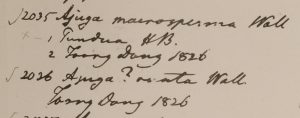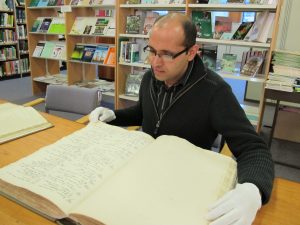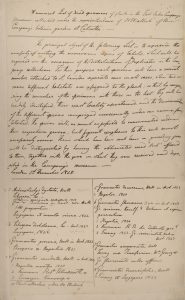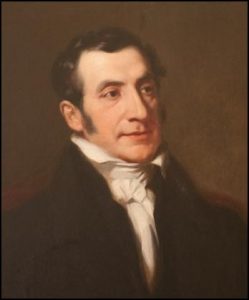Nathaniel Wallich and His Catalogue
From the time of his appointment as Superintendent at the Honourable East India Company’s (EIC) Botanic Garden at Sibpur near Calcutta (Kolkata) in 1815, Dr Nathaniel Wallich (1786–1854) started to amass a considerable herbarium of plant specimens on behalf of the EIC. This herbarium comprised of Wallich’s own collections made during his journeys through India, Nepal and Malaysia and from plants growing in the Calcutta Botanic Garden, but also included material gathered by his official collectors sent out to distant parts of the EIC territories, and from botanically-minded Europeans working for the EIC. Wallich sorted and provisionally named these collections whilst he was in Calcutta, but the main arrangement and distribution would wait until 1828 when Wallich travelled to London on special leave. The ‘Wallichan Distribution’ of the EIC Herbarium was possibly the most extensive and influential distribution of Asian and SE Asian botanical material ever to have been undertaken. Between 1828 and 1849, Wallich catalogued over 8500 species, some of which included many gatherings from different areas, and he sent tens of thousands of duplicates to over 60 botanists and institutes across Europe, and one in North America.
 Producing hand-written labels for so many specimens was an enormous task, and Wallich did not have the financial resources to employ a clerk nor to print labels by letterpress. Instead, Wallich chose to use the relatively new technique of transfer lithography to cheaply reproduce his hand-written lists of species names and collection data. The pages of double-columned lists, written by Wallich, and later partly by George Bentham (1800–1884), were printed on one side of thin, un-watermarked paper sheets of rather poor quality (ca. 45 x 28 cm). Batches of these pages were included with corresponding packets of herbarium specimens, which were sent out periodically from Frith Street in Soho. The main distribution was started in December 1828 and concluded in the summer of 1832, finishing with Entry No. 7683 on page 253. At this time indexes to genera and families were provided, on pages 254–268, the first produced by John Forbes Royle (1799-1858). Fifteen years later, in 1847, Bentham initiated the distribution of the remainder of the duplicates in the EIC Herbarium. The work was finally completed in November 1849 with Entry No. 8517 on page 306 – although no index was provided for the second phase of the distribution.
Producing hand-written labels for so many specimens was an enormous task, and Wallich did not have the financial resources to employ a clerk nor to print labels by letterpress. Instead, Wallich chose to use the relatively new technique of transfer lithography to cheaply reproduce his hand-written lists of species names and collection data. The pages of double-columned lists, written by Wallich, and later partly by George Bentham (1800–1884), were printed on one side of thin, un-watermarked paper sheets of rather poor quality (ca. 45 x 28 cm). Batches of these pages were included with corresponding packets of herbarium specimens, which were sent out periodically from Frith Street in Soho. The main distribution was started in December 1828 and concluded in the summer of 1832, finishing with Entry No. 7683 on page 253. At this time indexes to genera and families were provided, on pages 254–268, the first produced by John Forbes Royle (1799-1858). Fifteen years later, in 1847, Bentham initiated the distribution of the remainder of the duplicates in the EIC Herbarium. The work was finally completed in November 1849 with Entry No. 8517 on page 306 – although no index was provided for the second phase of the distribution.
 Very few sets of the Wallich Catalogue remain as stacks of unbound leaves, as some recipients cut up the pages as specimen labels (arguably Wallich’s original intention), but many recipients had the pages bound into a single volume – some of which are missing the later distribution of pages 269–306. The resultant book is usually referred to as the Wallich Catalogue (also Wallich’s Catalogue, Wallichian Catalogue, Wallich’s List or Wallich’s Numerical List), but the title on the first leaf of the lithographed series is:
Very few sets of the Wallich Catalogue remain as stacks of unbound leaves, as some recipients cut up the pages as specimen labels (arguably Wallich’s original intention), but many recipients had the pages bound into a single volume – some of which are missing the later distribution of pages 269–306. The resultant book is usually referred to as the Wallich Catalogue (also Wallich’s Catalogue, Wallichian Catalogue, Wallich’s List or Wallich’s Numerical List), but the title on the first leaf of the lithographed series is:
A numerical list of dried specimens of plants in the East India Company’s Museum, collected under the superintendence of Dr. Wallich of the Company’s Botanic Garden at Calcutta.
Wallich used many new plant names in the Wallich Catalogue, sometimes taking up the manuscript names of other botanists. As this work is reproduced by ‘indelible autograph’, it is considered ‘effectively published’ according to the International Code of Nomenclature, and so this is the first publication of many hundreds of names of Asian plants, making it a work of considerable importance to Asian botany. Unfortunately Wallich did not provide any descriptions of these plants and so the vast majority of these new names are ‘invalidly published’ as ‘nomina nuda’. However, Wallich’s names were frequently taken up and validly published by later authors, often using duplicate specimens from the EIC herbarium, and so the Wallich Catalogue is very important when considering the applications of these names and when choosing type specimens. Some of the new names in the Wallich Catalogue are considered as validly published through an often indirect reference back to a previously effectively published description. There are many cases in which the handwriting in the Wallich Catalogue is indistinct, or where abbreviations are used, and specialist interpretation of entries is often needed when investigating such more problematic cases.
 The top set of the EIC Herbarium is now at Royal Botanic Gardens, Kew (K-W), but duplicate specimens from the Wallichian Distribution can now be found in many herbaria worldwide, including Calcutta (CAL). The Wallich Catalogue is very important for Asian botany, but few copies still exist (perhaps no more than 50). The Inter Documentation Company (IDC) produced a microfiche reproduction of the Wallich Catalogue in 1971 (IDC Catalogue No 7394) using Bentham’s complete, original copy, which he presented to RBG Kew in 1854. A digital version of the Missouri Botanic Garden copy of the Wallich Catalogue is available on Biodiversity Heritage Library, but this copy as is made up of a mixture of Photostat copies and original lithographic sheets, which makes it rather problematic. The Photostat copies are derived from Asa Gray’s copy of the Wallich Catalogue in Harvard University, and are sometimes of poor quality and unreadable. Furthermore, the first page in Gray’s copy is different to the regular first page of all other original copies of the Wallich Catalogue so far seen, and this page seems to be an earlier printer’s proof.
The top set of the EIC Herbarium is now at Royal Botanic Gardens, Kew (K-W), but duplicate specimens from the Wallichian Distribution can now be found in many herbaria worldwide, including Calcutta (CAL). The Wallich Catalogue is very important for Asian botany, but few copies still exist (perhaps no more than 50). The Inter Documentation Company (IDC) produced a microfiche reproduction of the Wallich Catalogue in 1971 (IDC Catalogue No 7394) using Bentham’s complete, original copy, which he presented to RBG Kew in 1854. A digital version of the Missouri Botanic Garden copy of the Wallich Catalogue is available on Biodiversity Heritage Library, but this copy as is made up of a mixture of Photostat copies and original lithographic sheets, which makes it rather problematic. The Photostat copies are derived from Asa Gray’s copy of the Wallich Catalogue in Harvard University, and are sometimes of poor quality and unreadable. Furthermore, the first page in Gray’s copy is different to the regular first page of all other original copies of the Wallich Catalogue so far seen, and this page seems to be an earlier printer’s proof.
To add to the challenges presented by indistinct handwriting and interpretation of abbreviations, throughout the Wallich Catalogue we find frequent corrections and additions, which are not cross-referenced and therefore are often missed by those who are trying to interpret species entries in the Catalogue. In order to address these difficulties, RBGE is working on the production of an enhanced, digital version of one of its own copies of the Wallich Catalogue. This book was digitised with the help of a grant from the RBGE Friend, and has been fully indexed as part of the BHL Europe project. The electronic copy is now being annotated so that all the components of each species entry can be viewed together and linked with external data, such as digitised herbarium specimens. This stage towards producing an interactive, virtual version of the Wallich Catalogue, is nearly complete and tye results will be launched as a separate website in the near future.


4 Comments
4 Pingbacks